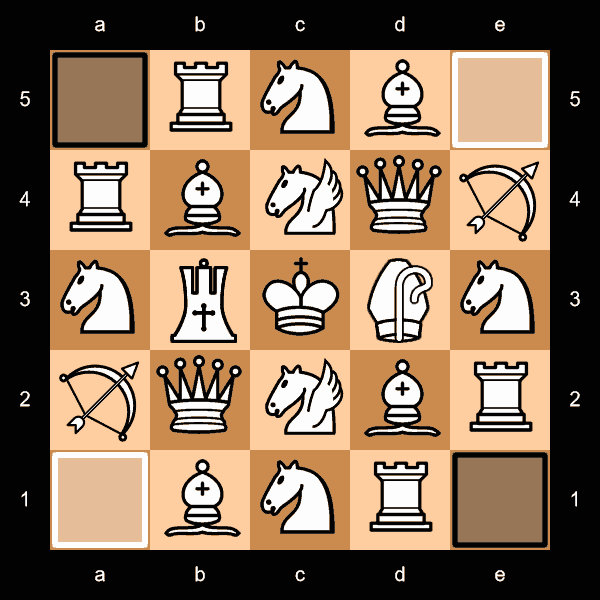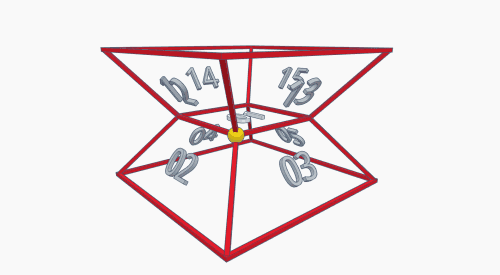Chess on a Tesseract
Way back in the 1970s, while I was playing the 3D variant called Strato Chess, I started to wonder (as others here have done) if the dimensions of the game couldn't be extended to four or even five. It took some time to figure out, so I set the idea aside.
Eventually, upon learning about such figures as the tesseract and penteract, I started to think about how we three-dimensional beings would interact with such things. I even started writing a story about a group of people trapped in a structure built around a pentaract (with similar effects to what I'm about to describe).
It was only relatively recently that I managed to put the two ideas together. The play is, at one level of thought, as two-dimensional as orthodox chess; but on another level, it still uses four dimensions of movement.
The Geometric Concept
This game is played, ostensibly, on the two-dimensional "faces" of a tesseract. To help understand how that works, let's subtract one dimension, and consider the edges of a cube.
Suppose this game were to be played in such a way (and I wouldn't put it past the contributors of this site to come up with one). When a piece reaches a corner, there are two other edges that it continue onto. How does one choose which to go to?
The principle is the same here. Each edge of a face meets an edge of two other faces; when a piece goes off the edge of a face, the player chooses which of the two connecting faces it goes to.
To help players keep track, each face has a number code to indicate show where it is.
These two (also clickable for a larger view) show the relationships of the Faces that White uses for Setup (below).
White's "Home Face" is numbered 00. Each has eight adjacent Faces, two for each side of the Home Face; these are the "Territory Faces."
Each of the Territory Faces has a path number, 1-4, indicating which side of the Home Face is used to reach it. Each also has a track indicator, A or B, for the two paths it can take when leaving the Home Face. For example, when moving "up" on 00 (as seen on the illustrations), White has the option of going to either 01A or 01B.
Where two Territory Faces meet, a piece may go to the neighboring Territory Face on the same track, or to an Open Space (see below). For example, on the border between 01A and 02A, there is also Face 12 (think of it as "one-two" rather than "twelve").
Black's setup is essentially the same, but on the opposite end of the tesseract. "Home Face" is 50 (again, think of it as "five-zero" rather than "fifty"), with the same four path numbers and the same two track indicators.
Another way of looking at the two flat diagrams is like this:
When a piece crosses to the far side of a Territory Face, one of its two options is to then go into the opponent's Territory Face with the same path and track. The other is to go to that track's Opposing Face (below).
This diagram shows the remaining six Faces, as a cutaway of the full tesseract. 12, 23, 34, and 14 are "Open Faces," connecting both tracks of two paths for both sides. For example, Face 12 "one-two") has sides connecting to 01A/02A, 01B/02B, 51A/51B, and 52A/52B.
AX and BX are special "Opposing Faces." They are where the places where all paths of a particular track converge; On the two cubes they touch, the opposite side of one is 00 and the opposite side of the other is 50. This makes them equidistant from both Home Faces in all directions.
These two faces work similarly to the Home Faces, except that the sides share path and track indicators, but are preceded by either 0 or 5. For example, moving "downward" on BX (as seen in the diagram just above), a piece could go to either 03B or 53B.
Setup
Boards
The 24 Faces of the tesseract are each made up of a 5x5 board. The corner spots of each board are blacked or whited out; no piece may enter or pass through them.
In a physical game, the boards can be laid out however you wish. Each should have an indicator as to which Face it represents, and a guide on each edge as to which two Faces it leads to.
Pieces
In the figure above, White sets up on and around Face 00 (the front of the "large" cube), while Black sets up on and around Face 50 (the back of the "small" cube); these are their respective "Home Faces." The setup is identical for both, so only White is illustrated.
(Don't worry; I'm only calling them "large" and "small" because they look that way in the illustration. On an actual tesseract, all 8 cubes are the exact same size.)
On each Home Face, the King goes in the center. Orthogonally adjacent, he's flanked by two Nightriders; each has a Queen clockwise from it, and a Bishop counterclockwise. The remaining two spaces next to the King are filled by an Archbishop and a Chancellor. The outer spaces, going around from the corner next to each Bishop, are filled by a Rook, Knight, Bishop, Archer, Knight, and another Rook.
These may be rotated however the player prefers, including reversing direction.

Adjacent to each side of the Home Face are two more Faces; these eight are the Territory Faces. On the edge of the Face adjacent to the Home Face, each player has a Berolina Spear, flanked by two Arabian Spears. The next row over has three Standard Pawns, one in the center and one at each end, with Berolina Pawns filling the other two spaces.

Physical Setup
While this may seem overwhelming, it's quite possible to set this game up for a face-to-face contest. It would require a large 3D setup, however; it would look something like this:

Each side has its Home Face front and center, with the eight Territory Faces arranged so that the respective side of the Home Face leads to the near side of the Faces next to it. Pawns and Spears are set up on the edge closest to the player (which is simplest and most natural).
In the Grey section, the Opposing Faces are raised up in the middle, while the Open Faces are on the sides.
(Further explanation, instructions, and better illustrations yet to come.)
Pieces
Each player is equipped with the following:
- 1 King
- 1 Archbishop
- 1 Chancellor
- 2 Queens
- 2 Nightriders
- 2 Archers
- 4 Bishops
- 4 Knights
- 4 Rooks
- 8 Berolina Spears
- 16 Arabian Spears
- 16 Berolina Pawns
- 24 Standard pawns
The pieces with links are either orthodox Chess pieces, or pieces familiar to most chess variant aficionados; the articles explain the moves. The other three pieces:
Archer: Moves two spaces diagonally, or "rifle-captures" (captures without moving) a Knight's move away.
Arabian Spear: A sort of "Pawnrider," moves without capture directly forward like a Rook, or captures forward like a Bishop.
Berolina Spear: Moves without capture forward diagonally like a Bishop, or captures directly forward like a Rook.
Pawn/Spear Movement
For Pawns and Spears, moving forward means whatever direction takes the piece closer to the opponent's Home Face. This means that the Spears will infrequently, and the Pawns almost never, move to any of the Open Faces or Opposing Faces; the shorter route from any Territory Face (where the Pawns and Spears start) to the opponent's Home Face always is always through an opponent's Territory Face. Where there's a choice between going to an Open Face or the enemy's Territory Face, or between the player's Territory Face or an Open Face, choosing the latter (in each pair) is mandatory.
Should a Pawn or Spear go to an Open Space, the closer direction is toward the nearest edge that leads to an opponent's Territory Face. If two (or more) are equidistant, the player may choose which way is forward.
On an Opposing Face, all directions are equal; Pawns and Spears suddenly have four-directional movement on these Faces, until they leave.
Rules
As noted above, when a piece reaches the edge of a Face, the player chooses which of two neighboring Faces it continues to. The move is as seamless as if the boards for the two Faces were set against one another.
The board setup makes Castling impractical, if not impossible. However, en passant is used with the Pawns (Standard and Berolina), though not the Spears.
In terms of the endgame (checkmate, stalemate, etc.), all standard rules are observed.
Both types of Pawn and both types of Spear promote upon entering the opponent's Home Face. They may promote to any type of piece that's used in the game, except of course for the King and other Pawns or Spears.
Notes
As a person on the autistic spectrum, one of the "plusses" I experience is the (generally useless) ability to, with some effiort, visualize four-dimensional space (or, with much effort and if the geometry is simple, even five; six is beyond me). Thus, I can visualize the actual tesseract in this game, while most if not all other people could not.
This was initially presented not so much as an actual, playable game, but as an exercise to help others visualize and understand higher spatial dimensions. As I've developed the game (with much help from Fergus Duniho and others), I found that a practical playspace would be very possible, and might even be easier to play on than a computer setup. The structure mentioned here is the theoretical version of that, but I hope to give it an actual try before long.
About That Story
The short story I mentioned in the Introduction got started, and I knew the ending as well as most of the plot points but never actually completed it past Page 2. It really was a story meant to explore the concept of moving around the three-dimensional aspects of five-dimensional space in the same way that this game explores two-dimensional aspects of four-dimensional space; one added feature was that, depending on the route one took, one could re-enter a room with "up" in a different direction than when one left, leading to some rather Escher-esque moments.
 This 'user submitted' page is a collaboration between the posting user and the Chess Variant Pages. Registered contributors to the Chess Variant Pages have the ability to post their own works, subject to review and editing by the Chess Variant Pages Editorial Staff.
This 'user submitted' page is a collaboration between the posting user and the Chess Variant Pages. Registered contributors to the Chess Variant Pages have the ability to post their own works, subject to review and editing by the Chess Variant Pages Editorial Staff.
By Bob Greenwade.
Last revised by Bob Greenwade.
Web page created: 2023-09-12. Web page last updated: 2023-12-16













